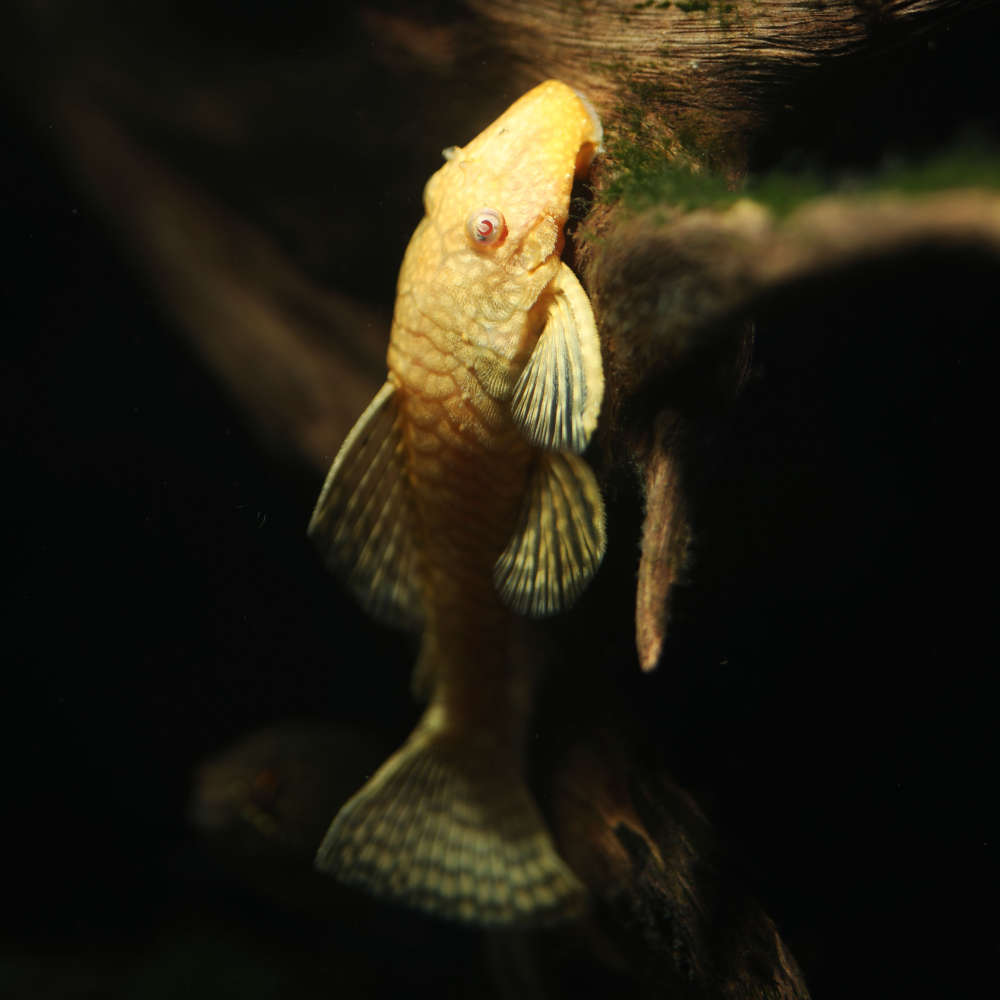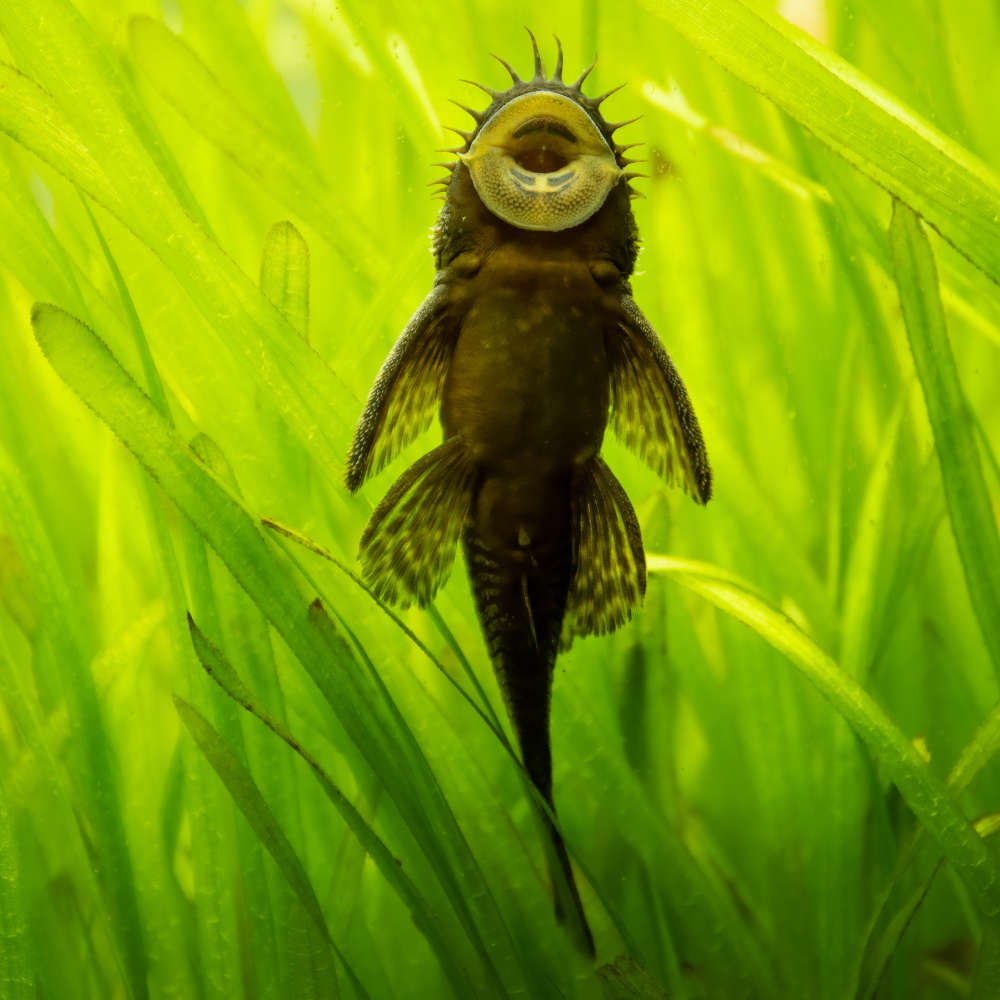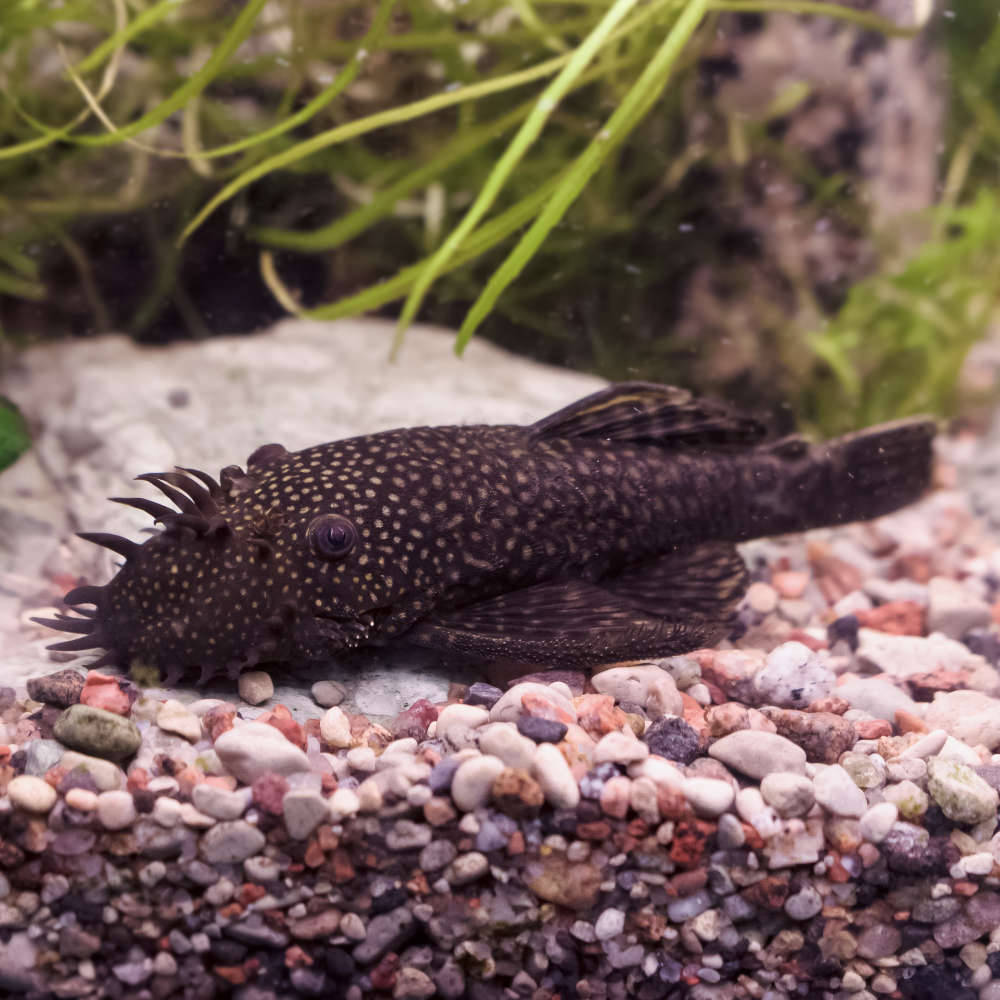What is bristlenose pleco?
Bristlenose pleco is a small armored catfish, and it’s popular in freshwater aquariums for its tank-cleaning abilities.
All species from the Ancistrus genus are called bristlenose or bushynose catfish/pleco. These belong to the Loricariidae family under the Siluriformes order.
The most popular bristlenose catfish is Jumbie teta. Its scientific name is Ancistrus cirrhosis.
Its small size, friendly nature, peaceful personality, moderate resistance, and voracious algae-eating habits make the omnivorous fish perfect for community tanks.
Where do bristlenose plecos live?
Bristlenose plecos are native to the Parana River basin and the Amazon River in South America. You can find them in both fast-flowing habitats with gravel substrate and turbid standing water with clay substrate. They’re often found in flooded forests during the wet seasons.
What does bristlenose pleco look like?
The bristlenose pleco can be identified based on its color, shape, scale, mouth, fins, and bristles.
- Color: The fish has an unevenly distributed brown, black, grey, and olive color base and yellow or white spots. It varies depending on its regional origin. The upper body is of a darker shade than its abdomen.
- Shape: It has a short, flat, plump body and a wide head.
- Scales: It is a scaleless fish but covered in bony plates, which protects it from other aggressive species in the wild.
- Mouth: It has a suckermouth on its underside. The mouth has powerful suction that helps the fish hold on to surfaces like wood and rocks in fast currents.
- Fins: It has a large fan-like dorsal fin on top, two abdominal fins, and two pectoral fins.
- Bristles: The bristles, whiskers, or fleshy tentacles on its snout are the most distinguishing features.
When do bristlenose plecos get their bristles?
Bristlenose plecos start to get their bristles around 4 to 6 months of age.
How can you differentiate between male and female bristlenose pleco?
The main differences between the male and female bristlenose pleco are based on the size, fins, and bristles.
- Size: The adult male fish is slightly bigger than the mature female fish.
- Fins: Unlike the female fish, the male has spikes on its fins.
- Bristles: The male fish has larger, longer, and more prominent bristles that grow higher on its head. The female fish has less prominent bristles that grow around the mouth.
What are the types of bristlenose pleco?
According to ITIS (Integrated Taxonomic Information System), 55 verified types of bristlenose plecos exist. Here, we’ll provide an overview of the 7 most popular ones among aquarium enthusiasts:
1. Albino Bristlenose Pleco
The albino bristlenose pleco lacks melanin and has a white or light yellow body and pink eye color. There’s a subdued yellow or pink marbled and spotted pattern on its body. The head is slightly wider.
2. Super Red Bristlenose Pleco
The super red bristlenose pleco has a bright orange or light red body. When the fish matures, it develops red speckles. It’s line-bred from the Calico variety.
3. Longfin Bristlenose Pleco
Unlike other varieties, the longfin bristlenose pleco has pretty long and flowy fins. The fins sway in flowing water, which is fun to observe.
4. Calico Bristlenose Pleco
Calico bristlenose pleco is mostly burnt orange with marble-patterned black patches. The mottling patches may also be red, brown, or cream-colored. This gives the fish a textured and elegant look.
5. Blue Eye Lemon Bristlenose Pleco
Blue eye lemon bristlenose pleco mostly comes in bright lemon yellow, but specimens or other shades of yellow are also available. It’s often confused with the albino type. The main distinguishing feature is its blue or very dark eyes.
6. Green Dragon Bristlenose Pleco
The green dragon bristlenose is available in a range of green shades, but it is mainly olive green. Some may be solid colored, while others are patterned with white, tan, yellow, brown, or even green.
7. Starlight Bristlenose Pleco
The starlight bristlenose has a pitch-black body with white flecks representing stars all over it. It also has a thin white stripe on the edge of the dorsal and tail fin.

How big do bristlenose plecos get?
The adult bristlenose pleco grows up to 8.9-12.7 cm (3.5-5 in) on average. The male fish might be slightly bigger than the female.
How fast do bristlenose plecos grow?
Bristlenose plecos reach their maximum length within 2 years.
Usually, the fry grows slowly and hardly reaches 2.5 cm (1 in) within the first 3 months. Past the 3-month mark, it grows pretty fast and can grow by an additional 5-7.6 cm (2-3 in) within 6 months of age.
How long do bristlenose plecos live?
In the wild, the pleco lives up to 5-7 years. It can survive up to 10-12 years in captivity with proper care.
How many bristlenose plecos in a tank?
Keep 1 bristlenose pleco in a minimum 25-gallon tank for comfortable housing. The solitary fish doesn’t need conspecific as companions. For a school of 5, a minimum 55-gallon tank is required.
How to maintain a bristlenose pleco aquarium?
To maintain a bristlenose pleco aquarium, mimic the fish’s natural habitat, like fine substrate, plants, and decor for shelter, soft lighting, effective filtration, and good water flow.
1. Substrate
Use a 3-inch deep, smooth substrate, as this fish spends most of its time at the bottom of the tank foraging on algae. Choose sand, mud, or clay substrate with gravel.
2. Plants
Incorporate plants like Anubias, Java fern, Amazon sword, dwarf water lettuce, and hornwort. The nocturnal fish needs lots of shade from lighting.
3. Lighting
Avoid using bright lights because bristlenose pleco has sensitive eyes. Use low to subdued lighting if you want to observe fish at night.
If you plan to keep only these fish, the tank does not need artificial lighting. Rely on natural light for plant growth.
4. Décor
Add lots of caves, rockwork, PVC pipes, and twisted roots as hiding and resting spots for the aloof fish. Strategically place a few pieces of driftwood for shelter and as a spot for algae growth, which the fish feed on.
5. Filtration
Use a robust filtration system like a canister or hang-on-back filter with the power to pump 300 gallons/hour to eliminate the bristlenose pleco’s heavy bioload.
Undergravel filter is another great option for maintaining clean tank water and keeping it well-oxygenated.
Even after using these filters, if the fish often darts to the surface, the tank isn’t well-oxygenated. In that case, incorporate airstones or powerhead for better tank aeration.
6. Water Flow Rate
Maintain moderate to strong water flow in the tank, similar to its natural habitat.
What are the ideal water parameters for bristlenose pleco?
The bristlenose pleco prefers soft and warm water, so the ideal water parameters to help the hardy fish live for the longest are as follows:
- pH Levels: 5.8-7.8
- Water Temperature: 73-81 °F (23-27 °C)
- Water Hardness: 2-20 dGH
- Ammonia: 0 ppm
- Nitrite: 0 ppm
- Nitrate: Less than 20 ppm
What do bristlenose plecos eat?
Bristlenose plecos love to eat algae, making them excellent cleaners for aquariums. The species are omnivorous in captivity. They primarily (95%) need an herbivorous diet but rarely snack on small carnivorous meals.
Feed them fresh fruits and blanched vegetables, sinking commercial food, and thawed frozen food for a healthy life ahead. Below is the list of food items you can feed them:
- Algae wafers
- Romaine lettuce
- Cilantro
- Broccoli
- Parsley
- Arugula
- Cantaloupe
- Spinach
- Pea
- Carrot
- Zucchini
- Brine shrimp
- Bloodworm
- Fish flake
Feed it two meals a day for two minutes each. After a few hours, get rid of leftovers to avoid nitrate spikes. By that time, the fish will find and munch on all the food on the substrate.
Avoid excessive live food as it might lead to swim bladder issues and constipation. Monitor whether your fish is well-fed or not, check its color. If it looks pale, it doesn’t get a balanced diet.

What are the recommended tank mates for bristlenose pleco?
The bristlenose pleco is generally peaceful and gets along well with most other peaceful and social community tank species of similar size and other algae eaters mentioned below:
- Neon tetra
- Guppy
- Platy
- Molly
- Barb
- Rasbora
- Dojo loach
- Swordtail
- Corydoras
- Gourami
- Danio
- Shrimp
- Crab
- Snail
For a school of bristlenose plecos, don’t add more than one male in the tank. Otherwise, they’ll get into territorial fights and even lead to tangling their bristles.
Avoid large, aggressive, semi-aggressive, and territorial species as tank mates to prevent stress-related diseases.
How to breed bristlenose plecos?
Bristlenose plecos are easy to breed once you mimic the ideal mating conditions of the wild, which is the rainy season of the Amazonian biotope. To successfully breed the fish, follow these steps:
1. Breeding Tank Preparation
Decorate a 75-gallon tank with lots of caves, rockwork, PVC pipes, other hiding spots, and driftwood. These work as spawning areas. Maintain the following water chemistry:
- pH Levels: 6.5-7
- Water Temperature: 72 °F (22 °C)
- Water Hardness: 5-10 dGH
2. Specimen Choosing & Conditioning
Choose one healthy male and three healthy female fish, each at least 15 months old. Condition them in the main tank with a diet of bloodworms.
Reduce the tank water temperature by a few degrees to make them anticipate the rainy season – when they spawn.
3. Breeding Tank Introduction
After a few days, introduce the chosen specimens in the breeding tank. Perform 75% water changes with cool water.
4. Mating
Once the male fish is ready, he seeks caves for his mates to lay eggs in. After choosing the spot, he cleans it and waits for a female fish or attracts a female fish.
To court the female, he extends his dorsal and tail fins, dances stunningly, and follows her around to entice and bring her over.
A female fish arrives voluntarily or after being courted and investigates the chosen spot. If she is not willing, she swims away. If she’s willing to spawn, she lays 20-200 sticky bright orange eggs on the floor and walls of the chosen spot.
5. Egg Caring
The male externally fertilizes the eggs. The male cares for the eggs and cleans the spot for the next 7-10 days. He removes bad/sterilized eggs that look yellow or glassy orange.
The female fish guards the cave. Parent fish don’t eat their own fry and are rather protective.
Remove any other female fish from the tank at this point.
6. Hatching & Fry
The eggs hatch in 4-10 days. The fry clings to the walls and floor of the chosen spot and absorbs their yolk sacs, which takes 2-4 more days.
After that, they become free swimmers and start nibbling on any algae formed in the tank.
You can feed them skinned and mashed peas, pulverized green flakes, and commercial fry food.
Once the young fish become strong enough and survive independently, the male fish lets them be on their own.


